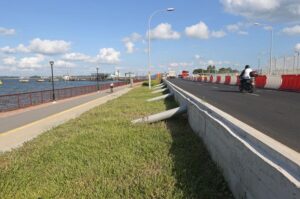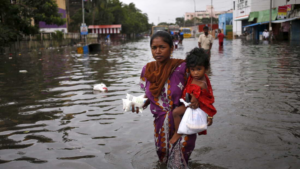Sea Level Rise Risks, Adaptation Strategies, and Real Estate Prices in Singapore
This study exploits the Singapore Prime Minister’s announcement of the areas affected by sea level rise (SLR) within the country and its adaptation strategies valued at 100 billion Singapore dollars. Utilizing transaction-level data with exact locations, we find that public housing prices dropped by 7.2% in SLR areas four years after the announcement relative to non-SLR areas. In SLR areas with adaptation, the price depreciation was mitigated to 0.6%. In the private housing sector, freehold properties benefit more from adaptation strategies than leasehold properties. We calibrate the long-term discount rates before and after the shock at 2.27% and 2.14% in SLR areas and 2.35% and 2.12% in SLR areas with adaptation, respectively. (JEL H43, R21, R28, R38, R51, Q54)
Consumption response to a natural disaster: Evidence of price and income shocks from Chennai flood
Agarwal, S., Ghosh, P., Zheng, H.(2024). Consumption response to a natural disaster: Evidence of price and income shocks from Chennai flood, Energy Economics, 131 (107323), https://doi.org/10.1016/j.eneco.2024.107323
In this paper, we utilize monthly individual-level financial data and item-level supermarket sales data to study how consumption responds to one of the costliest natural disasters in India. We find that consumption dropped by 11% during the disaster, 65% of which was recovered after the disaster. On average, consumption per capita dropped by $312 per year, which costs about 5% of the GDP. We also show that natural disasters depressed consumption through income shocks instead of price shocks. Consumers smooth consumption using credit card, banks loans and wealth in coping with the shocks.
Are environmental punishments good news or bad news? Evidence from China.
Agarwal, S., Ding, Y.H., Kuang, W.D., Zhu, X. (2023). Are environmental punishments good news or bad news? Evidence from China. Journal of Environmental Economics and Management, 120 (102847), https://doi.org/10.1016/j.jeem.2023.102847
This study investigates how the disclosure of environmental punishments influences housing prices in the context of rising public awareness of environmental issues. Examining data on firm-level environmental punishments and housing resale transactions in Beijing from January 2015 to December 2017, we observed a significant average price drop of 1.84% for houses located within 0.5 km of environmentally punished firms. The impact intensified with multiple environmental punishments and was more pronounced during heating seasons and national events. We identify three mechanisms explaining the effects of environmental punishments on housing prices: “information disclosure,” where the impact magnifies with public release and environmental information searching; “information dissemination,” revealing that negative effects decrease with distance and over time; and “health concern,” indicating stronger responses from older homebuyers and those with children compared to unmarried young homebuyers.
Life is Too Short? Bereaved Managers and Investment Decisions
Liu, C., Shu, T., Sulaeman, J., Shu, T., Yeung, P. (2023) Life is Too Short? Bereaved Managers and Investment Decisions”, Review of Finance, 27,4 ,1373-1421, https://doi.org/10.1093/rof/rfac067
We study how the loss of a family member affects the investment decisions of managers in large organizations. We discovered that when managers experience the death of a loved one, they tend to take fewer risks in making investment decisions. This was observed in both mutual funds and publicly traded companies. In the case of mutual funds managed by bereaved individuals, we noticed that they displayed smaller tracking errors, had lower active share measures, and allocated more of their portfolios to larger stocks after experiencing a bereavement event. Similarly, firms led by bereaved CEOs reduced their capital expenditures and made fewer acquisitions following such events. Our analysis indicates that these changes in behavior can be attributed to emotional factors rather than other explanations (e.g., attention distraction). The risk-averse decisions made by bereaved managers have negative consequences on the performance of the funds and companies they oversee.
Disguised pollution: Industrial activities in the dark
Agarwal, S., Han, Y., Qin, Y., Zhu, H., (2023). Disguised pollution: industrial activities in the dark. Journal of Public Economics, 223(104904), https://doi.org/10.1016/j.jpubeco.2023.104904
In this paper, we show that some Chinese firms, under the cover of darkness, emit increased amounts of sulfur dioxide (SO2). Using hourly pollution data from 1,583 national monitoring stations in China from January 2015 to December 2017, we found a significant increase in industrial toxin SO2 levels after sunset in highly industrialized areas. This insight enhances our understanding of industrial firms’ pollution practices. While these monitoring stations are strategically placed in heavily polluted industrial regions, nearby firms engage in covert pollution activities, taking advantage of the lack of direct government oversight, especially during nighttime hours. Our findings highlight the necessity for a more comprehensive environmental monitoring system, encompassing both daytime and nighttime operations and their associated toxic emissions. This system should extend its coverage beyond large corporations to include smaller firms in industrialized areas.
Startups’ demand for accounting expertise: evidence from a randomized field experiment
Gefen, O., Reeb, D. & Sulaeman, J. (2023) Startups’ demand for accounting expertise: evidence from a randomized field experiment. Review of Accounting Studies, https://doi.org/10.1007/s11142-023-09775-8
This paper examines whether startup companies prefer investors with accounting expertise. To test this, we conducted an experiment with over 13,000 startup companies in the US, sending them emails pretending to be interested investors, some with accounting certifications (CPA) and some without any special credentials. As a result, we found that the startups were more likely to respond to the emails from the investors with CPA certifications. This preference held even when the investors pretended to be different types of investors, such as angel investors or venture capitalists. This shows that startups value accounting expertise in their investors significantly. In a follow-up experiment, we found that startups preferred CPA-certified investors over those with a general business degree (MBA), reinforcing the importance of accounting expertise to them.
Expanding footprints: The impact of passenger transportation on corporate locations
Lin, Y., Qin, Y., Sulaeman, J., Yan, J., Zhang, J. (2023). Expanding footprints: The impact of passenger transportation on corporate locations. Review of Finance, 2023, 27, 1119–1154. https://doi.org/10.1093/rof/rfac049
Transportation plays a vital role in shaping where businesses thrive and grow. This study explores how making travel more convenient can help businesses expand into new areas and enhance communication between investors and companies. We focus on the effects of improving passenger travel in China through the High-Speed Rail (HSR) system. Using over 1 million firm-to-firm investment observations over the 12-year period, we find that when two cities are directly connected by HSR, the number of investments between them increases significantly by 8%, and the amount of investment grows by 45%. These results hold even when we account for differences between city pairs and local factors that might influence HSR route choices. Our results suggest that improved monitoring and access to information are essential drivers of the HSR’s effects.
Long-term effects of air pollution on Singapore’s national university admissions
Agarwal, S., Tan, P.L., Tan-Soo, J.S. (2023). Long-term effects of air pollution on Singapore’s national university admissions. Applied Economics Letters, 31(13), 1178-1183, https://doi.org/10.1080/13504851.2023.2177586
In this research, we examine the lasting effects of being exposed to haze pollution on university admissions in Singapore. Using the individual-level data from all university applicants in Singapore between 1981 and 2015, we discovered that people who were exposed to haze while in the womb during the episodes in April 1977 and October 1983 had lower admission scores and were less likely to get into university compared to those not exposed to haze. These effects were more pronounced for females. However, for the haze episodes in October 1991, August to October 1994, and August to October 1997, which were even more severe pollution events, we did not find the same negative impacts. These results show that air pollution’s long-term effects can vary. While the effects of the first two episodes lingered over time, the later three episodes suggest that negative impacts might be reduced due to economic progress and protective measures.
The effects of policy announcement, prices and subsidies on water consumption
Agarwal, S., Araral, E., Fan, M. , Yu, Q., Zheng, H. (2023) The effects of policy announcement, prices and subsidies on water consumption. Nat Water, 1, 176–186. https://doi.org/10.1038/s44221-023-00028-1
In our research, we investigate how alterations in water prices and subsidies influence water conservation in Singapore. Analyzing a decade of monthly billing data for 2.2 million residential accounts, we discovered that simply announcing a water price increase led to a 3.7% reduction in consumption, more impactful than the actual 30% price hike. Consumers who were more conscious of price changes responded more to the announcement, while those with higher water usage were more influenced by the actual price increase. Moreover, our research emphasizes that only through calibrated information provision and program design can we alleviate the financial burden on lower-income households’ water consumption while maintaining the positive water conservation effects resulting from a price increase. In summary, our results suggest that the traditional market-based policy instruments, such as price and subsidy, could be combined with “information salience” to achieve sustainable outcomes efficiently with minimal technology advancement cost.
Public media campaign and energy conservation: A natural experiment in Singapore
Agarwal, S., Sing, T.F., Sultana, M. (2022). Public media campaign and energy conservation: A natural experiment in Singapore. Energy Economics, 2022, 114 (106281), , https://doi.org/10.1016/j.eneco.2022.106281
Singapore uses public media campaigns to motivate public housing residents to conserve energy as part of its strategies to achieve sustainable energy goals. In this research, we aim to identify if these campaigns actually work in practice. Using the energy conservation campaign conducted in Singapore in January 2016, we found that in areas with the campaigns, people living in public housing used about 0.4% less electricity compared to those in places without the campaigns. We also discovered that this saving effect was not a one-time occurrence but has persisted even after the campaign. When we calculated its value in currency, we found that this program brought about S$350,000 in benefits for the people.










